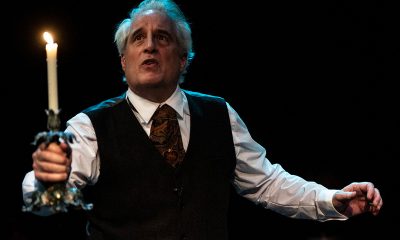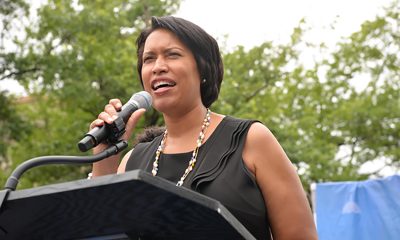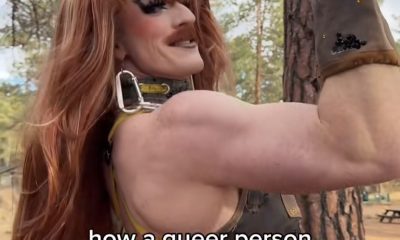Music & Concerts
REVIEW: Madonna’s joyful, nostalgic, chaotic ‘Celebration’
Fans got into the groove at Capital One Arena for two unforgettable nights
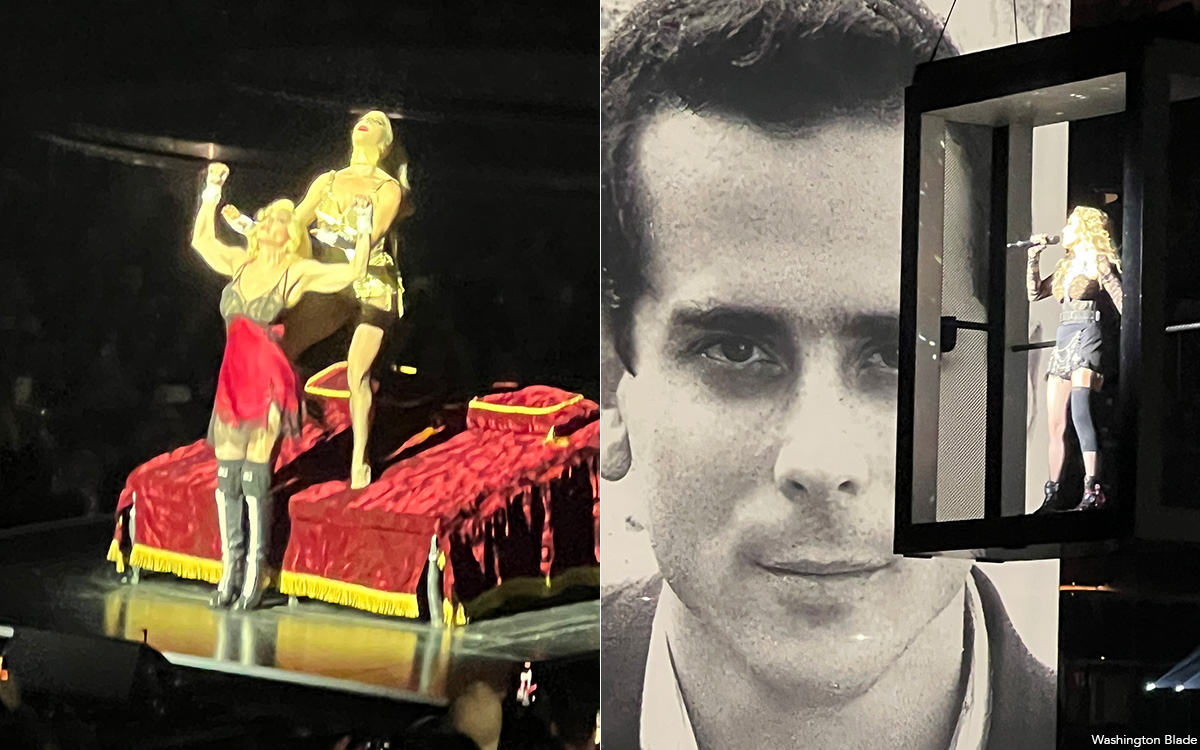
The entire two-plus hours of Madonna’s “Celebration Tour” seemed to build to a singular ecstatic moment when the pop and queer icon glided above the packed floor of Capital One Arena in a lighted box belting out her 1998 hit “Ray of Light.”
You could feel the arena move beneath your feet.
It’s difficult to capture in words the spectacle, sheer joy, and even sadness that characterize Madonna’s “Celebration Tour,” which played D.C. on Monday and Tuesday nights featuring 28 songs in seven “acts.” Let’s get her tardiness out of the way: Yes, she was late. Very late. The 8:30 p.m. start time turned into 10:30, which, considering the advancing age of her fanbase, proved a challenge for many on a school night. But the moment she hit the stage, all was forgiven.
Bob the Drag Queen was a capable, entertaining emcee, opening the show with a short monologue of praise and inviting the glitter/sequin/feather-adorned crowd to the celebration. With that, Madonna appeared on the tiered stage (a nod to her 1984 MTV Video Music Awards debut atop a wedding cake) and opened the show with the unexpected “Nothing Really Matters,” a surprising choice for a “greatest hits” show given it peaked at 93 on Billboard’s Hot 100 chart back in 1999 (though it did hit No. 1 on the dance chart that year). She wore a black kimono designed by Eyob Yohannes and a halo headpiece by House of Malakai, according to Harpers Bazaar. The look evoked her red kimono from the video.
From there, old school fans were treated to an ‘80s throwback and a recreation of Danceteria featuring club hits like “Everybody,” “Into the Groove,” and “Burning Up.”
The party anthem “Holiday” took a jarring turn as dancers were depicted dying on stage with Madonna using her coat to cover up one of them as the vibe quickly changed from intoxicating and fun to introspective and tearful as she transitioned to her 1986 ballad “Live to Tell.” In a show packed with highlights, this was the emotional core of the night. The song opened with two-story images of friends who had died of AIDS projected on giant screens around the stage; as the song progressed, the screens filled with more and more faces until the visages of hundreds of mostly gay men filled the arena with Madonna floating around them singing in tribute. It was a haunting moment and the most visually stunning sight I have ever witnessed in a concert. There wasn’t a dry eye in our row and I haven’t been able to get that image out of my mind for two days, a painful reminder of our community’s recent history and Madonna’s role as one of the few celebrities who stood with us in our darkest hour. She has more than earned our loyalty after fighting for AIDS awareness and funding and standing up to everyone from the Pope to the Boy Scouts advocating for our basic humanity.
After the emotional pull of that number, we needed some levity and Madonna delivered by pivoting to “Like a Prayer” featuring a giant carousel filled with her mostly shirtless dancers and a minute of chanting and a Sam Smith-Kim Petras “Unholy” snippet followed by a raucous version of the smash hit song.
Moving into act three, “Erotica” arrived with the dancers dressed as boxers in a ring with laser lights instead of ropes. There was an interlude featuring a dancer dressed as a Blond Ambition-era Madonna on a red velvet bed, another nod to an iconic Madonna moment, followed by “Justify My Love” with the scantily clad dancers writhing around their queen.
One of my personal highlights followed as Madonna’s daughter Mercy James killed it, skillfully playing piano as her mother sang “Bad Girl,” another surprise setlist inclusion from 1992’s “Erotica” album. Though the single didn’t fare well on the charts, the David Fincher-directed video remains one of her absolute best, depicting Madonna as a Manhattan business executive who drinks and smokes excessively and embarks on a series of one-night stands that leads to her murder. Christopher Walken co-stars in the video, which was influenced by Wim Wenders’s acclaimed “Wings of Desire.” Mercy is clearly no nepo-baby; she’s a talented pianist who wowed the crowd.
Next up was “Vogue,” which saw Madonna strutting the runway in a Jean Paul Gaultier-designed little black dress complete with conical bra and ending with a tribute to the ‘80s ballroom scene with Bob the Drag Queen in the role of Billy Porter from “Pose.”
Act V commenced with a rather drawn out recording of “The Beast Within,” the 1990 track that features spoken word passages from the Book of Revelation. She’s included this one on several tours. It wasn’t a hit song and we’ve seen it multiple times before so it felt unnecessary.
“Don’t Tell Me” saw the return of cowboy hats and line dancing, a spirited highlight of the night. Shortly after, Madonna slowed things down with a moody cover of “I Will Survive,” a poignant moment given her recent bout with a serious bacterial infection that led to the tour’s postponement.
But she was saving the best for last, as Act VI debuted with Madonna in a glittering Versace catsuit sprawled on a box singing “Bedtime Story” before rising to the rafters and tackling the aforementioned “Ray of Light.” It was an electric rendition that had the thousands of attendees on their feet.
So, what didn’t work? There were a few missteps, chief among them a misguided tribute to Michael Jackson at the end of the show that depicted silhouettes of Michael and Madonna dancing to “Billie Jean” and “Like a Virgin.” The comparison screamed “He’s the King of Pop and I’m the Queen” — it felt thirsty and superfluous. The whole “Queen of Pop” debate smacks of 20th century sexism, especially in an era of Taylor Swift and Beyonce billion-dollar tours. Madonna should be over that by now. Further undermining the comparison, Michael Jackson detested Madonna and was caught on an audio recording calling her a “nasty witch” and accusing her of being “jealous” of his popularity. She should cut this segment from the show.
One friend described the show as “chaotic,” which it was at times, but that stems from trying to cram a 40-year catalogue of hit songs into a two-hour show. Some of the show’s transitions were abrupt but, again, when you have as many hits as she does, you have to move fast.
Another issue was the lack of a live band, which she’s included on previous tours. I think most concert-goers paying hundreds of dollars for a ticket expect to see and hear a band. Instead, she relied on a recorded track for the music and some of the vocals. But Madonna’s mic was live and she did sing most of the show. As for the dance moves, Madonna has certainly slowed down from previous tours; her dancing isn’t nearly as athletic as in tours past. But she’s 65 years old and the leg brace she’s worn on stage clearly shows she’s suffering from so many years of entertaining us in high heels. She can leave the moves to her coterie of dancers and focus on singing.
She closed the show abruptly with a combo of “Bitch I’m Madonna” and a truncated “Celebration,” the tour’s namesake.
In all, a festive and nostalgic night with Madonna serving up hits and memories spanning decades for her adoring fans dressed in all sorts of tribute attire. If you’re on the fence about going, let me push you off. Go see her before she retires from touring. Yes, you’ll have to stay up late and indulge a few misguided moments. But our icons are aging and dying and no one can fill Madonna’s shoes. The show is a party, a walk down memory lane, and, yes, a Celebration.
Music & Concerts
Queer mega stars (and allies) ready to take D.C. stages this fall
Watch LGBTQ icons light up stages across the DMV as they sing, dance, and drag their way through spectacular shows.
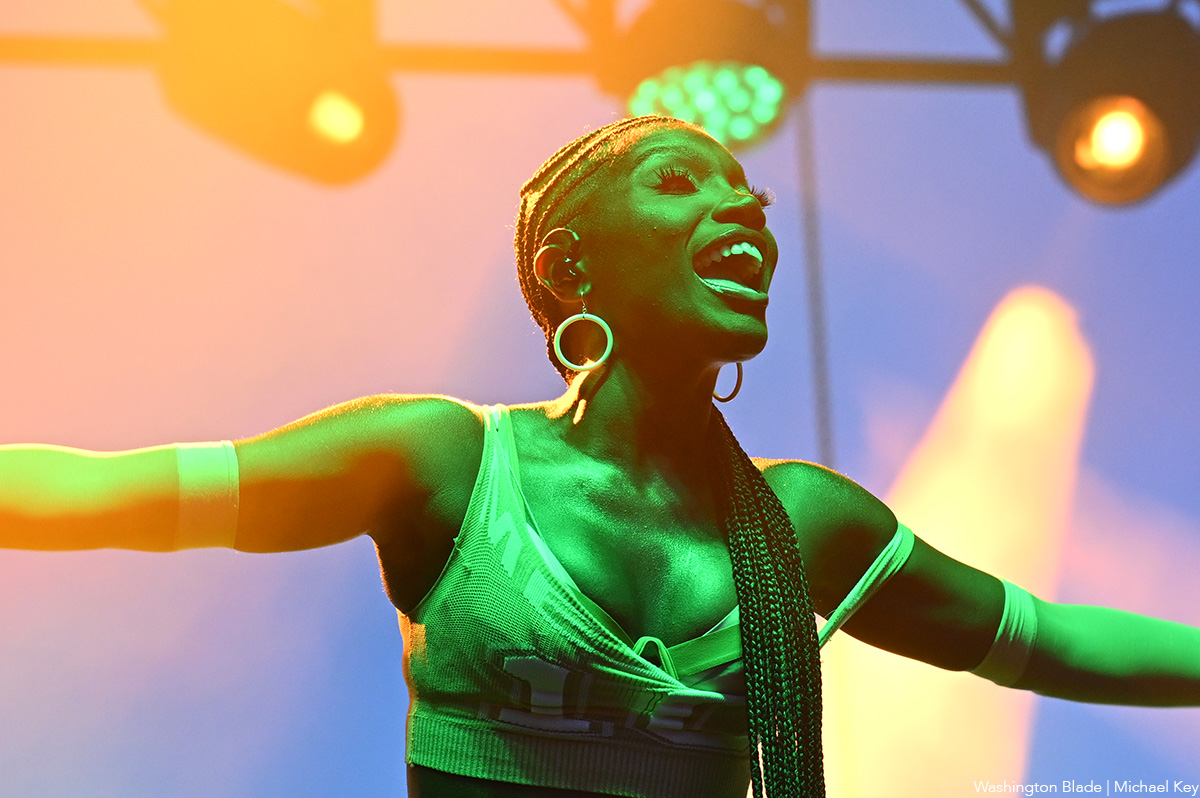
One of the best ways to welcome fall is by catching LGBTQ performers (and their allies) lighting up some of the D.C. area’s biggest stages. From country and pop to drag and rock, the season is packed with shows you won’t want to miss.
Maren Morris – The country, rock, and pop diva—known for hits like “The Bones” and for standing up against Nashville’s anti-LGBTQ voices—takes the stage at Wolf Trap (1551 Trap Rd, Vienna, Va.) on Friday, Sept. 12 at 8 p.m. Tickets start at $64.
RuPaul – The mother of modern drag and host of “RuPaul’s Drag Race” will spin a DJ set at Echostage (2135 Queens Chapel Rd NE) in Northeast D.C. on Sept. 20. Before RuPaul swaps wigs for headphones, Trade and Number 9 owner Ed Bailey will warm up the decks. For tickets and details visit echostage.com.
Conan Gray – The queer pop prince, celebrated for his Gen Z anthems like “Heather” and “Maniac,” brings his Wishbone Pajama Show to EagleBank Arena in Fairfax, VA, (4500 Patriot Cir) on Sept. 20 at 8 p.m. Tickets start at $113. For more info visit shop.conangray.com/pages/tour.
All Things Go Music Festival – With a lineup that includes Noah Kahan, Lucy Dacus, Kesha, Clairo, Doechii, and more, the beloved LGBTQ-friendly festival takes over Merriweather Post Pavilion (10475 Little Patuxent Pkwy, Columbia, Md.) Sept. 26–28. For tickets and details visit allthingsgofestival.com.
BERTHA: Grateful Drag – This unique tribute brings drag artistry and the sounds of the Grateful Dead to The Atlantis (2047 9th St NW) on Sept. 27. Tickets start at $47 at theatlantis.com.
Peach PRC – Rising Australian pop star and out lesbian, whose confessional tracks like “Perfect for You” and “Forever Drunk” have made her a queer TikTok darling, performs at The Atlantis on Sept. 29 at 6:30 p.m. The show is general admission only. Additional details are on theatlantis.com.
Addison Rae – The TikTok star-turned-pop princess, who’s crossed over into music with glossy hits like “Diet Pepsi” brings her sold out show to The Anthem (901 Wharf St., S.W.) on Sept. 30. Tickets are sold out, but resale options start around $80. For more info visit theanthemdc.com.
The Rocky Horror Picture Show 50th Anniversary – Celebrate the cult classic that’s been a queer midnight-movie staple for decades, with Barry Bostwick (a.k.a. Brad Majors) at the Warner Theatre (513 13th St., N.W.) on Oct. 2 at 8 p.m. Tickets start at $41 via Ticketmaster.
Chaka Khan, Patti LaBelle, Gladys Knight & Stephanie Mills – Four legends, one stage. Between Khan’s funk, LaBelle’s soul, Knight’s R&B, and Mills’ powerhouse vocals, this concert at Capital One Arena (601 F St NW) on Oct. 3 at 8 p.m. promises pure diva magic. Tickets start at $103. For more details visit capitalonearena.com.
Lorde – Joined by The Japanese House and Chanel Beads, the Grammy-winning New Zealand singer-songwriter behind “Royals” and “Solar Power” returns to The Anthem on Oct. 4 at 7 p.m. Lorde has long been embraced by queer fans for her dreamy pop and subversive lyrics. For more info visit theanthemdc.com.
Andy Bell (of Erasure) – The British queer rock icon, best known for synth-pop classics like “A Little Respect” and “Chains of Love,” brings his Ten Crowns Tour to the Lincoln Theatre (1215 U St., N.W.) on Friday, Oct. 17 at 8 p.m. Tickets are $90.45.
Doechii – The self-described queer “Swamp Princess”—and WorldPride 2025 headliner—continues her breakout year with the Live from the Swamp Tour at The Anthem on Oct. 21 at 8 p.m. Known for blending rap, R&B, and avant-garde performance art, Doechii is one to watch. Tickets start at $153.
Neon Trees – The out-and-proud Utah rockers behind “Everybody Talks” and “Animal” perform at the Lincoln Theatre on Friday, Oct. 24 at 8 p.m. Lead singer Tyler Glenn, who came out publicly in 2014, has become a strong queer voice in alternative rock. For tickets and info visit impconcerts.com.
Sasha Colby – The “RuPaul’s Drag Race” Season 15 winner strips down on the Stripped II Tour at the Warner Theatre on Nov. 2 at 8 p.m. Tickets available now on Ticketmaster.
Lola Young – The bisexual indie-pop sensation, whose raw songwriting has earned her millions of TikTok fans and multiple chart soaring hits visits The Anthem on Nov. 9 at 8 p.m. Tickets are still available.
Opera Lafayette
Featuring Mary Elizabeth Williams as Dido
+ Elijah McCormack, Chelsea Helm
Oct. 16, 7:30 p.m.
Sixth & I
PostClassical Ensemble
The Pale Blue Do: A Musical Voyage Inspired By Nature
Featuring National Geographic’s Enric Sala, Guest Curator
Wednesday, November 19, 7:30 p.m.
Terrace Theater
Washington Concert Opera
Starring Kate Lindsey, Theo Hoffman, John Moore, and Fran Daniel Laucerica
Nov. 23, 6 p.m.
Lisner Auditorium
Washington Master Chorale
An intimate a capella concert taking place in an architectural jewel, featuring cherished choral gems from Anglican and Catholic tradition and early American hymns. The concert will also present the world premiere of Christopher Hoh’s Holy, Holy, Holy is the Lord God of Hosts, and hymn singing featuring Robert Church, organist and choirmaster at St David’s.
Oct. 18, 7:30 p.m.
October 19, 5 p.m.
St. David’s Episcopal Church
Music & Concerts
Cyndi Lauper ready to have fun in Virginia
Superstar to bring final leg of farewell tour to Jiffy Lube Live
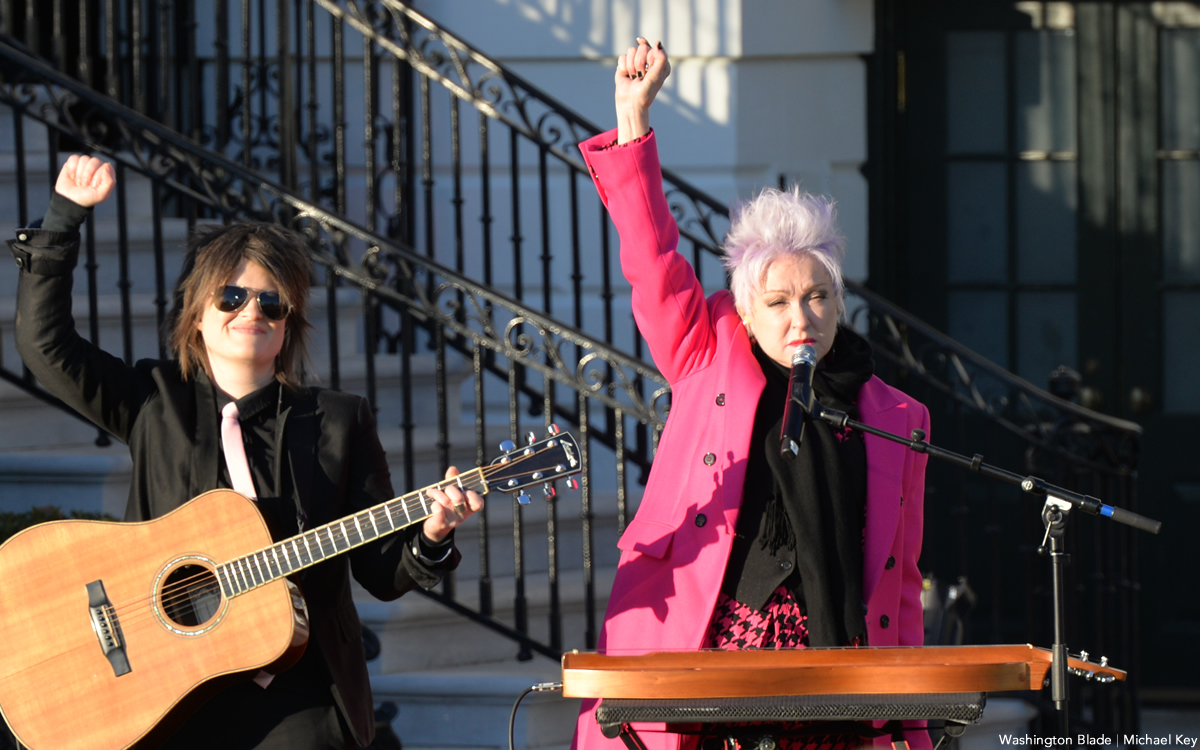
Superstar Cyndi Lauper will bring the final leg of her farewell tour “Girls Just Wanna Have Fun” to Bristow, Va., on Thursday, July 24 at Jiffy Lube Live.
Lauper’s international Farewell Tour – her first major headlining run in a decade – kicked off in North America last October, and included her first time ever headlining (and selling out) Madison Square Garden. Lauper’s performances have earned raves from the New York Times, Rolling Stone, Billboard, and many more, and surprise guests have included Chaka Khan, Sam Smith, and Hayley Williams. The tour just visited the U.K. and Europe, and will head to Australia and Japan in April.
Tickets are available on Live Nation’s website.
Music & Concerts
Red, White, and Beyoncé: Queen Bey takes Cowboy Carter to D.C. for the Fourth of July
The legendary music icon performed on July 4 and 7 to a nearly sold-out Northwest Stadium.
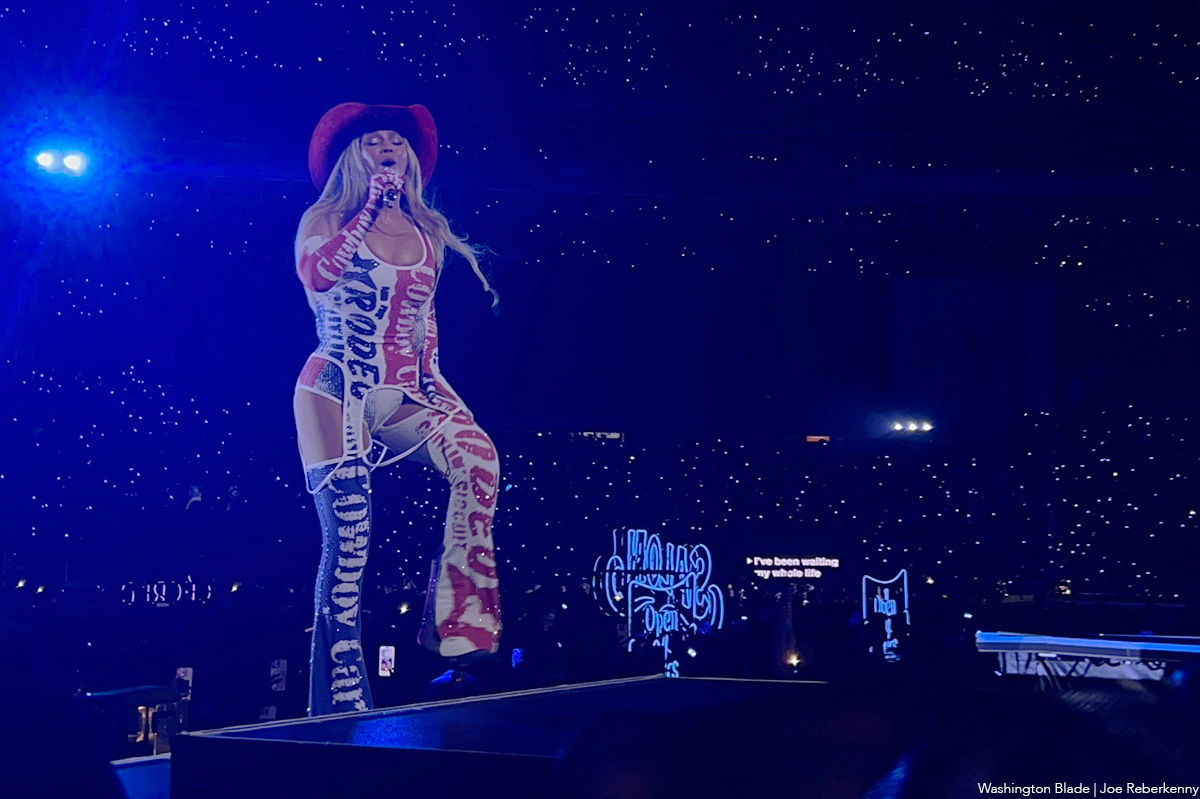
Just in time for Independence Day, Beyoncé lit up Landover’s Commanders Field (formerly FedEx Field) with fireworks and fiery patriotism, bringing her deeply moving and genre-defying “Cowboy Carter” tour to the Washington, D.C. area.
The tour, which takes the global icon across nine cities in support of her chart-topping and Grammy-winning country album “Cowboy Carter,” landed in Prince George’s County, Maryland, over the Fourth of July weekend. From the moment Beyoncé stepped on stage, it was clear this was more than just a concert — it was a reclamation.
Drawing from classic Americana, sharp political commentary, and a reimagined vision of country music, the show served as a powerful reminder of how Black Americans — especially Black women — have long been overlooked in spaces they helped create. “Cowboy Carter” released in March 2024, is the second act in Beyoncé’s genre-traversing trilogy. With it, she became the first Black woman to win a Grammy for Best Country Album and also took home the coveted Album of the Year.
The record examines the Black American experience through the lens of country music, grappling with the tension between the mythology of the American Dream and the lived realities of those historically excluded from it. That theme comes alive in the show’s opening number, “American Requiem,” where Beyoncé sings:
“Said I wouldn’t saddle up, but
If that ain’t country, tell me, what is?
Plant my bare feet on solid ground for years
They don’t, don’t know how hard I had to fight for this
When I sing my song…”
Throughout the performance, Beyoncé incorporated arresting visuals: Black cowboys on horseback, vintage American iconography, and Fox News clips criticizing her genre shift — all woven together with voiceovers from country legends like Dolly Parton and Willie Nelson. The result was a multimedia masterclass in storytelling and subversion.
The “Cowboy Carter” tour has been a social media sensation for weeks, with fans scrambling for tickets, curating elaborate “cowboy couture” outfits, and tailgating under the summer sun. At Commanders Field, thousands waited in long lines for exclusive merch and even longer ones to enter the stadium — a pilgrimage that, for many, felt more like attending church than a concert.
One group out in full force for the concert was Black queer men — some rocking “denim on denim on denim on denim,” while others opted for more polished Cowboy Couture looks. The celebration of Black identity within Americana was ever-present, making the concert feel like the world’s biggest gay country-western club.
A standout moment of the night was the appearance of Beyoncé’s 13-year-old daughter, Blue Ivy Carter. Commanding the stage with poise and power, she matched the intensity and choreography of her mother and the professional dancers — a remarkable feat for someone her age and a clear sign that the Carter legacy continues to shine.
It’s been nearly two decades since Beyoncé and Destiny’s Child parted ways, and since then, she’s more than lived up to her title as the voice of a generation. With “Cowboy Carter,” she’s not just making music — she’s rewriting history and reclaiming the space Black artists have always deserved in the country canon.
-

 District of Columbia2 days ago
District of Columbia2 days agoBowser announces she will not seek fourth term as mayor
-

 U.S. Military/Pentagon2 days ago
U.S. Military/Pentagon2 days agoPentagon moves to break with Boy Scouts over LGBTQ and gender inclusion
-

 Drag3 days ago
Drag3 days agoPattie Gonia calls out Hegseth’s anti-LGBTQ policies — while doing better pull-ups
-

 District of Columbia3 days ago
District of Columbia3 days agoSecond gay candidate announces run for Ward 1 D.C. Council seat

